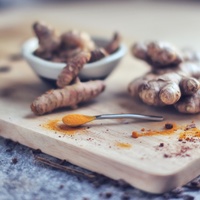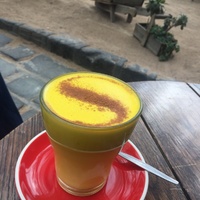Common name: Turmeric
Other common names: Curcuma, Indian saffron, Long rooted curcuma, Yellow ginger
Description
Turmeric is native to southern India and Sri Lanka where it is said to have been in use for more than 5000 years, primarily for the yellow dye which is extracted from the rhizomes, are part of the plant's root system. Through introduction and cultivation, turmeric is now naturalized in China, Africa, Taiwan the Caribbean and other many other warm climate regions around the world. Its usefulness today extends from colouring to spice, cosmetics and even medicine.
Historians claim that Marco Polo, while on one of his several legendary voyages to India via the Silk Route, was impressed by turmeric and had recorded it as a vegetable that possesses the properties of saffron.
The plant is similar in its appearance, growth habit and growing requirements to both ginger and galangal. It is an erect perennial herb, with upright stems emerging underground from rhizomes to form thick clumps, or stands between 80 cm and 1 meter in height.
Turmeric has lush green leaves which have a long, narrow oval shape ending in a point at the tip and are almost equal in length to the height of the stems they grow on. They grow in an alternate pattern up the length of the stems.
Flowers are mostly white, with some cultivars producing yellow flowers. They are small and are borne in a dense arrangement on flower spikes atop tall flowering stems. Cardamom -Leaves are oval to sword shaped, 30 to 70 cm long, lush, smooth, with a dark green colour on the surface and a paler green underside. The leaf is aromatic when crushed, giving off a ginger like aroma.
It is used primarily as a colouring agent for curries, sauces and pickles, although all parts of the plant are edible and fresh rhizomes impart a spicy, pungent flavour to fish and rice dishes.
Grows best in tropical to subtropical climates. In tropical climates it
is best grown for turmeric production at elevations between sea level
and 1200 meters, but performs best at elevations between 300 and 900
meters. Optimal climates are humid with average daily high temperatures
ranging between 20 and 28 C.
Turmeric is native to the monsoon forests of Indian and Sri Lanka.
It requires a well-drained soil, frost-free climate and 1000 to 2000mm
of rain annually or supplementary irrigation. It thrives best on loamy
or alluvial fertile soils and cannot stand waterlogging. Heavy shade
will reduce the yield but light shade is beneficial.
The plant does not fruit and therefore does not produce seed. Cuttings: The rhizomes are separated and cut into 10 cm lengths. All root growth and soil particles are removed. Clean cuts are made through the rhizomes before planting Division: The plant is most easily and commonly grown by division. In winter, at the end of the growing season when the plant becomes dormant, the rhizomes can be unearthed and divided for replanting The rhizome can be dug up at the end of the growing season [winter months] and cut into sections, each with 2 to 3 healthy eye buds. Plant sections horizontally in 4 cm of good quality compost and give light shade and regular moisture. Once established the rooted section can be transplanted to their final position. Plants are spaced at 50 cm apart
Plant divisions 1 meter apart in well-drained soil enriched with organic
matter, like chicken manure, covering the rhizomes twice as deep as
their diameter. If the plant is allowed to dry out, the leaf margins
quickly turn brown
After planting water regularly and do not water again until the shoots
appear, growing out of the soil. Once the plant is growing vigorously
water again but do not allow the soil to become waterlogged.
Use: The dried rhizomes yield an orange-yellow essential oil with a slight luminance, extracted by steam distillation. It was more widely used in the past for adding spicy flavour to food and to a lesser extent as a fragrance component in perfumery, for its oriental notes.
[Edit]



